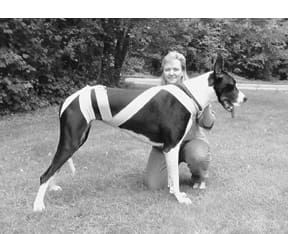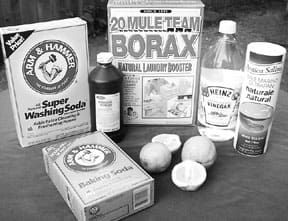People who are interested in feeding a home-prepared diet to their dogs often delay the transition as they grapple with various concerns. Frequently, they have come to believe the claims that a home-prepared diet offers dogs superior nutrition and can result in increased health and vigor…but they are still beset by fears that their dogs will suffer a broken tooth or perforated intestines caused by eating raw bone fragments. Others worry that their dogs won’t eat the vegetable matter in the diet, or will be put off by the addition of supplements. Still others cite their lack of time available for preparing the food.
Happily, all of these concerns (and more) can be put to rest with the purchase and use of a food grinder!
Just about every experienced feeder of a home-prepared diet owns and uses a food grinder. Many use grinders to reduce the raw meaty bones they include in their dogs’ diets to a smooth, pulpy consistency. Grinding the bones enables them to offer their dogs every advantage of consuming the nutrient-rich food, without any of the risks often dramatically cited by opponents of home-prepared diets. Ground to a smooth paste, the raw bones cannot break or crack a tooth, or block or perforate a dog’s intestines.

In addition, grinding all (or most) of the components of a dog’s diet together makes it impossible for a dog to “pick out” the ingredients he may not like. Dogs who fuss over the addition of any sort of herb or nutritional supplement to their usual meals generally can’t detect it when it has been thoroughly ground together with delicious meaty bones.
Finally, using a grinder to prepare and mix the dog’s food – often in batches that can be portioned and refrigerated or frozen for feedings later that week or so – saves a lot of time. Ask people who have fed a big dog (or several dogs) a home-prepared diet for more than a year, and they will just about always tell you that their investment in a food grinder has made the food-preparation job exponentially easier and less time-consuming.
Which grinder?
The variety of grinders available today allows interested dog owners to try out home-prepared canine diets on a small scale, or to fully commit to the “bones and raw food” (“BARF”) feeding plan. The size and cost of the model they settle on for the long term tends to reflect the size and/or number of dogs they have to feed. But whether they make food for one small dog or a whole pack of bigger canines, experienced dog “chefs” list the same desirable features they look for in a food grinder. Listed in no particular order, the criteria include:
• Durability: The cutting pieces of any food grinder will certainly be made of a high carbon steel, but the housing and the “worm” (the piece that moves the food material through the grinder) may be molded plastic, aluminum, tin coated cast iron, or stainless steel. The quality of the materials and manufacturing will certainly impact the grinder’s durability, but so will the ingredients you use in your dog’s diet. Whole grains, hard vegetables such as carrots, and mammal bones are the usual suspects involved in grinder breakage.
• Ease of cleaning: Any part of the grinder that comes into contact with food – especially raw meats and bones – must be cleaned after each use to avoid bacterial contamination. If a part isn’t easy to clean, chances are it won’t get cleaned properly, and can then harbor bacteria, causing illness.
• Power or capacity to suit your needs: Again, the power and capacity you need depends on your dogs and the ingredients you employ in their diet. But in general, the more food you make, the more power you’ll want. Hand grinders (the old-fashioned kind that clamp onto a countertop) may be sufficient for preparing small amounts of food, but out of the question for those who make food for a giant breed or several dogs.
• Ease of operation: The easier it is to operate, the more likely it is that you will be inspired to use the machine. If making your dog’s food turns out to be an hours-long project – to feed the machine slowly, manage drippings, and clean the working parts – you’ll tend not to use the grinder frequently or spontaneously.
• Good warranty or service agreement: These agreements should be explicit, easy to understand, and provide for returns or repair in case of equipment failure. Many equipment suppliers tend to have a specified period refund policy (frequently 30 – 90 days), perhaps minus re-stocking fees, but some suppliers do not allow returns on food service equipment at all. Before you invest in a grinding appliance, check to see whether or not it comes with a supplier’s or manufacturer’s warranty for parts and/or labor, and what conditions of use are not protected under the warranty.
While the purchase of a small household appliance needn’t break the bank, you don’t want to purchase a big-ticket item that will take up space sitting unused on a kitchen counter. On the other hand, you don’t want to hamstring your efforts; if you are dedicated to preparing food with the best ingredients for your dog’s health and well-being, a more powerful, higher capacity (and expensive) grinder may be more economical in the long run. Consider your time, storage space, and economic resources as part of a cost-benefit analysis before deciding which grinder to buy.
From least to greatest
We asked a number of long-time BARF feeders to describe their experience with food grinders. Their comments are arranged below according to the cost of the grinder they use, from the inexpensive but useful hand grinder, to the undisputed king of home-prepared dog diets: The Northern Tool & Equipment 70-pound food grinder.
Hand grinders
Upstate New York resident Alex Murphy began her grinding career with a hand grinder picked up at the Salvation Army for $3. “It worked pretty well, but it was a chore to clean up because it wasn’t sealed. If you were to grind something that contained moisture – which was just about everything I used – the liquid would drip from the grinder onto the floor! I used to spread a vinyl tablecloth on the floor and the table, and set a bowl beneath the grinder. I also remember that when washing the grinder, I had to dry it really well to avoid rust spots.
“Other than that, it was great, especially with my husband doing the heavy-duty grinding for me. It was a little harder to grind the thicker stuff, such as pumpkin, since I use seeds, skin, and all. It was messy, but worth it for the first couple of months when I was deciding what I was going to buy!”
Heavy tin-plated cast-iron hand meat grinders can be seen at Pierce Equipment’s Web site (pierceequipment.com or 877-354-1265). Prices range from $50 – $100, depending on size (20 – 30 pounds).
Northern Tool also makes a hand grinder, which is rated to grind 5 pounds of meat per minute. This grinder sports a 4″ x 5″ hopper for easy loading, and sells for $35 (see northerntool.com or 800-221-0516).
By the way, when searching these manufacturers’ Web sites for food grinders, use the word “meat” in your search. For some reason, the grinders did not come up when we searched on “grinder.”
Small kitchen appliances
Alex Murphy now uses a grinder attachment on her KitchenAid mixer to make food for her large dog (and one cat). “For a while I made a ‘veggie slop’ with my food processor, but that took a lot of time. The KitchenAid mixer has an attachment made of heavy plastic with metal parts. I don’t think it’s as durable as a cast metal product; that’s why I won’t grind anything harder than chicken necks.” Murphy chops the greens prior to grinding. This keeps them from wrapping around the “worm” that moves the food material through the grinder.
When asked whether she had plans to upgrade, Murphy responds, “I have no plans to buy a conventional grinder. This setup meets all my needs perfectly; it has good power, it’s easy to clean, the attachment takes up very little space, and as I already had the mixer – and the grinder attachment was only $50 – I’m really getting my money’s worth. So far, I am the only raw feeder I know who uses this attachment for BARF preparation, but I would recommend it for others who don’t make tons of food.”
KitchenAid mixers can be found in kitchen supply stores, in a range of models that range from the Classic ($200 for 250 watts) to the Artisan ($255 for 325 watts), to the Professional 6 ($365 for 525 watts). You can buy KitchenAid mixers in discount restaurant supply stores, or from kitchenaid.com, or by calling the manufacturer direct at (800) 541-6390.
Small motorized grinders
Several models generating a lot of buzz among BARF discussion groups are small in size (7 – 8 pounds), moderate in power (180 – 220 watts), easy to take apart and clean, and relatively inexpensive ($110 -$130). However, they may or may not be up to every dog owner’s food-grinding regimen. The longevity of the tools depends heavily on the amount and type of food put through the grinder.
Kristen Randall, a New Hampshire resident, started out by chopping vegetables in a food processor, and was thrilled to learn that her new grinder – the #5 food grinder made by Maverick – did a better job and was also much quicker. Elated, Randall reported her dazzling prowess with the grinder to a raw-feeding online discussion group one day, but posted dismal news the next; the grinder had hit a snag, melting down after a heavy session of chicken-neck and vegetable grinding.
“After my husband ground up about 10 pounds of necks and about an equal amount of vegetables, the grinder started making a loud squealing sound. He assumed it was a lubrication problem inside the grinding parts. But then I took that off and ran the motor alone, and it still makes that sound. It sounds just like an old fan I have whose bearings are shot.”
How could this happen? Confoundedly, the Pierce Food Service Equipment catalog urges buyers to “Grind up fresh bear, deer, duck, elk, meats, game, fruits and vegetables. Known to be good for grinding up pet food.” But it also states elsewhere, “If you are planning on returning this unit, it must be unused. It cannot be re-sold for new if you use it. You pay for return shipping to us. Pierce and Maverick do not state this grinder will grind bones, use at your own risk.”
Made in Poland, Maverick grinders (Maverick MM 1886 and Maverick MM 6386) are sold online by Pierce Equipment (www.pierceequipment.com or 877-354-1265) and many kitchen supply stores.
We found several other small motorized grinders in this category offered for sale online. S.D. Payton, who makes food for four Dobermans and two American Eskimo dogs, offered this review: “With the help of an experienced grinder friend, I chose the Moulinex DR7 from Small Appliance Service Company for around $117, a great grinder at the dollar amount I could afford. Moving up to the 440-watt (from my last grinder at 150), seemed to make a lot of difference in grinding chicken backs. I also like the reverse button just in case I need it.”
The Moulinex DR7 (440 watt) costs about $117 from Small Appliance Service Company Ltd. at www.edmart.com/SASCO or (780) 425-9550.
The Northern Tool & Equipment Co. offers a wide range of electric meat grinders. The smallest is rated at 250 watts and can grind two pounds of meat per minute. This four-pound machine comes with two grinding plates (coarse and fine), and is sold for $40. The 16-pound grinder is rated at 1000 watts, and comes with fine, medium, and coarse grinding plates. It is promoted as useful for grinding poultry, beef, vegetables, and more, and is priced at $100. The feed tube is 2 ½” at the top, large enough to feed in good-sized chunks. Northern Tool’s customer service representatives say that both grinders can safely grind chicken backs.
In our survey, we heard nothing bad about Northern Tool’s customer service or 90-day complete warranty. For an additional $6.99, you may purchase the manufacturer’s extended warranty, which offers to totally replace your grinder if it fails within one year. Northern Tool & Equipment Co., www.northerntool.com or (800) 221-0516.
Large motorized grinders
For 40 years and counting, Mary Stickney, of Cortland, Nebraska, has fed her pack of toy rescue dogs home-prepared diets. A huge advocate of the BARF diet, Stickney grinds an array of raw meaty bones (RMBs), including chicken wings, turkey necks, pork neck bones, turkey wings, lamb ribs, rabbit quarters, and organ meats such as beef heart, liver, and gizzards. She adds this ground RMB mix to ground vegetables and other foods in the following proportions: about 70 percent RMBs, 10 percent organ meat, and 20 percent vegetables, fruit, eggs, and ricotta cheese.
Stickney doesn’t add grains, explaining that several of her dogs are allergic to them. She presently prepares food for 10 small dogs and four cats. On grinding days, she fills a clean Coleman cooler with her mixture, which she then packages into one-gallon Ziplock bags and freezes for later use.
A frequent participant in online raw foods discussion lists, Stickney freely offers counsel to hesitant beginner and novice feeders. She feels that the one most important piece of advice for those just starting out is to “Get a good quality grinder to start with. I wasted $99 on a Maverick and broke it twice grinding lamb ribs. The larger Northern Tool Grinder is well worth the $269 purchase price. It eats chicken leg quarters whole like butter!”
Tori Muir, of Gilbertsville, Pennsylvania, concurs with the warm review. “The Northern Tool rules! When I was told that it would take a turkey neck with no problem, I had to get it. The machine is very sturdy, takes all but the hardest bones, and has no problems with fat, which clogs up other machines. It has lots of power, and a great customer service department if you have any questions. When the on/off switch failed, Northern Tool paid the shipping to return the machine, and sent me a new one!”
“I began feeding raw foods to my two 50-pound dogs about four months ago, starting off with whole RMBs. Upon finding large pieces of bone in Petey’s stools, I decided to go on a grinder hunt. I joined a bunch of BARF chat groups, and people guided me to the Northern Tool 1 horsepower/650 watt model. I started with chicken backs, wings, and necks. They all went through effortlessly. So I tried turkey; turkey necks went through easily if they fit through the feeding chute. Sometimes they needed to be cut or mashed first. Now I was having fun, so I tried pork and lamb necks. They needed to be split, but went through fine.”
Muir also reports that she has jammed the grinder with ox tails and beef ribs, and the large end of big turkey wings, so she quit using those RMBs. Those experiences did not darken her appreciation for the grinder. She describes how she recently ground 90 pounds of venison in an hour and a half, “Effortlessly,” she says delightedly.
With such glowing reports, could there be any downsides to the largest Northern Tool grinder? Well, considers Muir, “The unit is 70 lbs, and large to store. Mine has started rusting on the inside of the feed tube; I hadn’t thought about calling customer service about that. It can be difficult to clean, but I am one of the last people still without a dishwasher.” She adds, however, “Those negatives are negligible to me,” since the grinder performs so well.
Feeling grinder envy? I have to admit that I sure did after chatting with owners of the most productive and easy-to-use grinders. With volume production, reliability, and versatility in mind, you should now be armed with enough information to choose an appropriate model for you and your dogs. Good luck, and happy grinding!
-by Susan Eskew
Susan Eskew is a freelance writer (and wife of a veterinarian) currently living in North Carolina.















